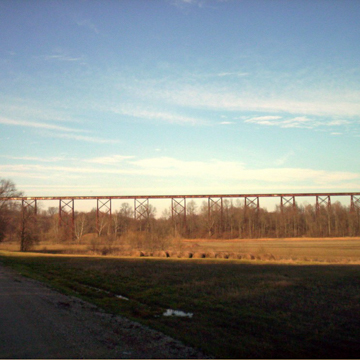You are here
Greene County Viaduct
Sources differ as to the precise length of this stunning railroad trestle that crosses the Richland Creek Valley in Greene County, but it is approximately 2,300 feet long and 157 feet above the ground, supported by eighteen steel towers. The bridge and railroad track together weigh nearly 2,900 tons. The trestle’s remote location makes its appearance all the more amazing as one maneuvers through the forested hills on the narrow, curving county roads to reach the observation park, built in 2015, by the side of the road. The sight thrills railroad enthusiasts, industrialist archaeologists, and Sunday drivers alike.
The Greene County Viaduct, also known as the Tulip Trestle (named for the nearest community) and the Richland Creek Viaduct, was built by the Indianapolis Southern Railway to haul coal from the fields in this part of the state to Indianapolis and destinations in Illinois. Financing for the project was provided by the Illinois Central Railroad, which took over the line in 1911. The railroad offered passenger service as well, which was discontinued in 1948.
Groundbreaking for the project began in May 1905. The American Bridge Company made the steel frames. After the Collier Bridge Company set the concrete pylons in place, the Strobel Steel Construction Company assembled and erected the components. The narrow rail bed rests on tall steel plate girders and is supported by a series of steel towers with X-bracing. All of the main components of the towers are made from paired steel channels connected by lattice and zig-zag webbing. At the time of its completion in December 1906, the Greene County Viaduct was the longest railroad trestle in the United States and was believed to be the third longest bridge of its kind in the world.
The line and the massive bridge are currently maintained and used by the Indiana Railroad, which hauls mainly coal but also agricultural products.
References
Hall, Tom. “Tulip Trestle.” Bridge Hunter. Accessed April 13, 2018. https://bridgehunter.com/.
Writing Credits
If SAH Archipedia has been useful to you, please consider supporting it.
SAH Archipedia tells the story of the United States through its buildings, landscapes, and cities. This freely available resource empowers the public with authoritative knowledge that deepens their understanding and appreciation of the built environment. But the Society of Architectural Historians, which created SAH Archipedia with University of Virginia Press, needs your support to maintain the high-caliber research, writing, photography, cartography, editing, design, and programming that make SAH Archipedia a trusted online resource available to all who value the history of place, heritage tourism, and learning.

